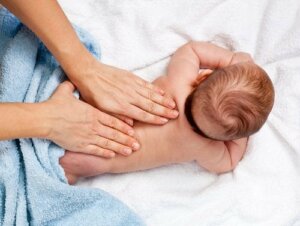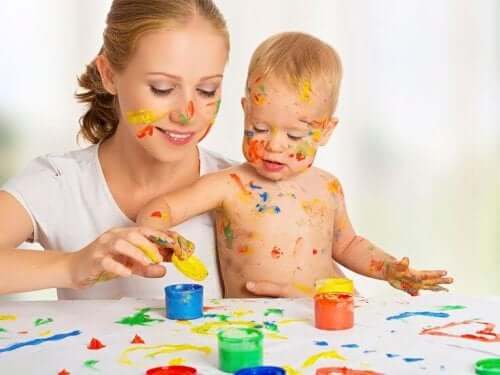Sensory Stimulation for Babies: Successful Tactics

Sensory stimulation for babies never hurts. In fact, it’s very favorable for their development and allows us to interact in a fun and friendly way with them. And this reinforces the paternal bond.
Remember that both the brain of babies and our own brains work with the information provided by the senses plus the vestibular and proprioceptive systems. This way, children learn to know and function in the world.
Sensory stimulation for babies
The sense of touch
To stimulate the sense of touch in your baby, you should choose some of these activities, according to his age. Surely you’ve already tried some and have others in mind:
- With the same soft brush you use to comb their hair, tickle them as you brush her skin.
- Offer them objects of different textures. You can buy lightweight plastic or styrofoam balls the size of a baseball and cover them with different surfaces: Cotton, cloth, bubble wrap, aluminum foil, cellophane. You must be very careful that the materials you choose don’t come off and that they can’t put them in your mouth.
- Fill some buckets with grains of different sizes, one with rice, another with chickpeas, and another with marbles for example. Hide some toys inside so they have to reach in with their hands and explore inside. Make sure they don’t put anything in their mouth.
- Let them explore, play, and cover themselves with food. Babies love smearing baby food on their faces and arms. It’s important that you let him try to eat by themselves. For your peace of mind, you can give them food from another plate so you’ll know that they’re well fed.
- Let them play with slimy substances like gelatin or some modeling clay. On the other hand, take them to the beach and let him experiment with the sand.

The sense of taste
- As soon as your pediatrician allows it, introduce new foods into their diet that invite them to discover new textures, new flavors, and new smells. At first, they’ll be surprised. This is part of what it means to discover and awaken their senses.
- Also, offer food with different temperatures.
The sense of smell
- Give him the smell of fruits and teach them to enjoy the smell of certain foods.
- When they’re older, they can play blindfold and guess what foods different smells represent.
- Teach them to be curious with their nose. For example, allow them to smell their creams and their shampoo from time to time.
The sense of hearing
- Talk to your baby. There’s nothing that delights babies more than Mom’s voice. Play and make different voices with funny gestures.
- Sing to them! Don’t be afraid, children always think that their mother sings well.
- Let them play by making noise with different kinds of paper, such as cellophane, or by tearing up pieces of newspaper.
- Offer toys that make noise or toy musical instruments.
- Speak to them in simple words and short sentences. You don’t need to overgesticulate or pronounce words excessively slowly.
- Let them play with their own voice, you’ll see how during a certain stage, your baby will scream and smile. They love this.
The sense of sight
- Put at their disposal a variety of mobiles. You can also add and vary pendants to mobiles at home.
- Take your baby for a walk in the park or to a family member’s garden. Look at the plants, birds, and clouds in the sky. This is very positive sensory stimulation.
- Offer toys of various colors, bright, opaque, phosphorescent, pastel, monochrome, with lights, etc.
- Teach them to follow toys with their eyes. Move them gently in front of them horizontally, from side to side, also from top to bottom.
- Show them stories with large, colorful pictures.

Beyond the five senses
The vestibular system
- Put your baby on their back and on their stomach at times.
- Place them on a large beach or exercise ball and rock it gently.
- Rock them in your arms, in the rocking chair, or in a baby hammock.
- Dance with them. Follow the rhythm of the music.
Proprioceptive system
- Infant massages are great for early sensory stimulation.
- Gently squeeze their arms and legs so they’re aware that they’re there.
- Roll them up in a blanket like a burrito for a couple of minutes and then let them go.
Take advantage of your daily routine to incorporate these little sensory stimulation activities. However, don’t overdo it, as they can promote hyperactivity. And of course, if your child’s uncomfortable with the activity, be sure to stop. You can always try again another day.
Sensory stimulation for babies never hurts. In fact, it’s very favorable for their development and allows us to interact in a fun and friendly way with them. And this reinforces the paternal bond.
Remember that both the brain of babies and our own brains work with the information provided by the senses plus the vestibular and proprioceptive systems. This way, children learn to know and function in the world.
Sensory stimulation for babies
The sense of touch
To stimulate the sense of touch in your baby, you should choose some of these activities, according to his age. Surely you’ve already tried some and have others in mind:
- With the same soft brush you use to comb their hair, tickle them as you brush her skin.
- Offer them objects of different textures. You can buy lightweight plastic or styrofoam balls the size of a baseball and cover them with different surfaces: Cotton, cloth, bubble wrap, aluminum foil, cellophane. You must be very careful that the materials you choose don’t come off and that they can’t put them in your mouth.
- Fill some buckets with grains of different sizes, one with rice, another with chickpeas, and another with marbles for example. Hide some toys inside so they have to reach in with their hands and explore inside. Make sure they don’t put anything in their mouth.
- Let them explore, play, and cover themselves with food. Babies love smearing baby food on their faces and arms. It’s important that you let him try to eat by themselves. For your peace of mind, you can give them food from another plate so you’ll know that they’re well fed.
- Let them play with slimy substances like gelatin or some modeling clay. On the other hand, take them to the beach and let him experiment with the sand.

The sense of taste
- As soon as your pediatrician allows it, introduce new foods into their diet that invite them to discover new textures, new flavors, and new smells. At first, they’ll be surprised. This is part of what it means to discover and awaken their senses.
- Also, offer food with different temperatures.
The sense of smell
- Give him the smell of fruits and teach them to enjoy the smell of certain foods.
- When they’re older, they can play blindfold and guess what foods different smells represent.
- Teach them to be curious with their nose. For example, allow them to smell their creams and their shampoo from time to time.
The sense of hearing
- Talk to your baby. There’s nothing that delights babies more than Mom’s voice. Play and make different voices with funny gestures.
- Sing to them! Don’t be afraid, children always think that their mother sings well.
- Let them play by making noise with different kinds of paper, such as cellophane, or by tearing up pieces of newspaper.
- Offer toys that make noise or toy musical instruments.
- Speak to them in simple words and short sentences. You don’t need to overgesticulate or pronounce words excessively slowly.
- Let them play with their own voice, you’ll see how during a certain stage, your baby will scream and smile. They love this.
The sense of sight
- Put at their disposal a variety of mobiles. You can also add and vary pendants to mobiles at home.
- Take your baby for a walk in the park or to a family member’s garden. Look at the plants, birds, and clouds in the sky. This is very positive sensory stimulation.
- Offer toys of various colors, bright, opaque, phosphorescent, pastel, monochrome, with lights, etc.
- Teach them to follow toys with their eyes. Move them gently in front of them horizontally, from side to side, also from top to bottom.
- Show them stories with large, colorful pictures.

Beyond the five senses
The vestibular system
- Put your baby on their back and on their stomach at times.
- Place them on a large beach or exercise ball and rock it gently.
- Rock them in your arms, in the rocking chair, or in a baby hammock.
- Dance with them. Follow the rhythm of the music.
Proprioceptive system
- Infant massages are great for early sensory stimulation.
- Gently squeeze their arms and legs so they’re aware that they’re there.
- Roll them up in a blanket like a burrito for a couple of minutes and then let them go.
Take advantage of your daily routine to incorporate these little sensory stimulation activities. However, don’t overdo it, as they can promote hyperactivity. And of course, if your child’s uncomfortable with the activity, be sure to stop. You can always try again another day.
All cited sources were thoroughly reviewed by our team to ensure their quality, reliability, currency, and validity. The bibliography of this article was considered reliable and of academic or scientific accuracy.
- Buendía, M. R. P. (2021). Una experiencia innovadora en Infantil: la Estimulación Temprana. EDU REVIEW. International Education and Learning Review/Revista Internacional de Educación y Aprendizaje, 9(4), 425-449. https://journals.eagora.org/revEDU/article/view/3117/1795
- Cabrera, M.C. y Sánchez C. (1982). La estimulación precoz; un enfoque práctico. Editorial Siglo XXI: España.
- Carrera-Ibáñez, A. (2021). Usos y aplicaciones actuales de la música en la gastronomía: estado de la cuestión (Bachelor’s thesis). https://reunir.unir.net/handle/123456789/11924
- Dorance, S. y Matter, P. (2001). Juegos de estimulación para los más pequeños. Madrid: AKAL.
- Flores, J. (2013). Efectividad del programa de estimulación temprana en el desarrollo psicomotor de niños de 0 a 3 años. Revista Ciencia y Tecnología, 9(4), 101-117. http://revistas.unitru.edu.pe/index.php/PGM/article/view/426
- Gallahue, D. (1982). Understanding motor development in children. New York: John Wiley and sons.
- Guerrero, A. M., & Primaria, I. Y. (n.d.). La estimulación temprana. https://archivos.csif.es/archivos/andalucia/ensenanza/revistas/csicsif/revista/pdf/Numero_14/AMALIA_MORENO_1.pdf
- González Zúñiga Godoy, C. I. (2007). Los programas de estimulación temprana desde la perspectiva del maestro. Liberabit, 13(13), 19-27. http://www.scielo.org.pe/scielo.php?pid=S1729-48272007000100003&script=sci_arttext&tlng=en
- Moreno, J. A. (1999). Motricidad infantil. Aprendizaje y desarrollo a través del juego. Murcia: Diego Marín.
- Moreno, J. A., & De Paula, L. (2006). Estimulación de los reflejos en el medio acuático. Revista Iberoamericana de Psicomotricidad y técnicas corporales, 6(2), 193-206. https://www.um.es/univefd/reflejos.pdf
- Ordoñez, M. y Tinajero, L. (2012). La importancia de la estimulación temprana en la etapa infantil. Madrid, 208-240.
This text is provided for informational purposes only and does not replace consultation with a professional. If in doubt, consult your specialist.








